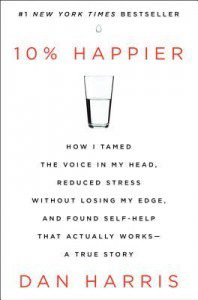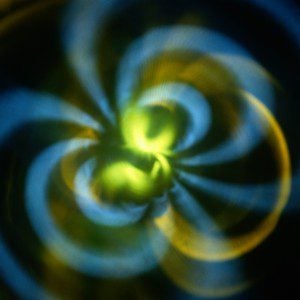Greetings faithful readers. I have been busy finishing up the final draft of my forthcoming book The Awakened Introvert: A Practical Mindfulness Skills to Help you Maximize Your Strengths and Thrive in a Loud and Crazy World (New Harbinger, Spring 2015). I had a chance to read the conversation between the Harris’s and it got me thinking about dualism versus non-dualism. I’ve excerpted some quotes from that dialog and see my commentary below.
Dan Harris, author of 10 Percent Happier: How I Tamed the Voice in My Head, Reduced Stress Without Losing My Edge, and Found Self-Help That Actually Works—A True Story, talked with Sam Harris (no relation) author of The End of Faith, on his blog Taming the Mind.
Dan: “It’s this thunderous truism: We all know on some level that we are thinking all the time, that we have this voice in our heads, and the nature of this voice is mostly negative. It’s also repetitive and ceaselessly self-referential. We walk around in this fog of memory about the past and anticipation of a future that may or may not arrive in the form in which we imagine it.”
Sam: “And this is why training the mind through meditation makes sense—because it’s the most direct way to influence the mechanics of your own experience. To remain unaware of this machinery—in particular, the automaticity of thought—is to simply be propelled by it into one situation after another in which you struggle to find lasting fulfillment amid conditions that can’t provide it. So there is a point to meditation after all—but it isn’t a goal-oriented one. In each moment of real meditation, the self is already transcended.
“When you turn attention upon itself and look for the thinker of your thoughts, the absence of any center to consciousness can be glimpsed immediately. It can’t be found by going deeper. To go deep—into the breath or any other phenomenon you can notice—is to start looking out the window at the trees. “It simply doesn’t matter what the contents of consciousness are. The self is an illusion in any case.
I liked the analogy of looking at the glass. You can see your reflection or you can look through to the world. By following the breath out there in the world, you will eventually, reach back to the reflection. All the techniques are like scaffolding (or the raft image the Buddha used; once you use the raft to cross the river, you don’t carry it on your back). Once you have gotten far enough along with the project of getting to know yourself as a human becoming (notice I didn’t say “being”) you don’t need the scaffolding anymore and you can dismantle it. In other words, technique is a transition to a less formal place. That is where you’ll find your reflection, as it were.
The goal reinforces the self that tries to reach the goal. The major work of the practice is to keep showing up and try to be open to what is happening.
A lot of what they discussed is covered by the Third Noble Truth. Self is a construction, it is fabricated when we project a sense of ownership onto our experience. When we can stop doing that, we are nirvana. We are not adding anything to the experience of consciousness. S. Harris is talking about looking at the source of that construction. When we can turn attention to that source that construction, seemingly solid otherwise, becomes flimsy and may collapse. When it collapse the duality disappears, if momentarily. I’m not sure if the Buddha used the language of non duality, but the cessation of nirvana is the same thing.
The question of wanting leads us to the constructedness of self. Remember the exercise of asking what is it that I am seeking when my attention moves away from now? These departures from the moment are in the service of this constructed self. In fact, these desires are what keeps that building up. When the desires stop, the construction collapses and there you are in consciousness without a subject and object.
Sam: “The non-dual truth is that consciousness is already free of this thing we think we have in our heads—the ego, the thinker of thoughts, the grumpy homunculus. And the intrinsic selflessness of consciousness can be recognized, right now, before you make any effort to be free of the self through goal-oriented practice. Once you have recognized the way consciousness already is, there is still practice to do, but it’s not the same as just logging your miles of mindfulness on the breath or any other object of perception.”
Yes. It is all available to anyone in any instant. However, the more you practice, the more opportunity you’ll have to experience it. It is like what Ben Hogan (I think) said about luck, “The more I practice, the luckier I get.” When I was on retreat, the teacher Rodney Smith talked a lot about presence. I think this was his term for the non-dual awareness. We get to presence by relinquishing all secondary agendas. Easier said than done but that presence IS available always but it not reached for as much as revealed.
Sam: “Technically, it’s not true mindfulness at that point, but even when one is really balanced with one’s attention, there is still the feeling that one is patiently contemplating one’s own neurosis. It is another thing entirely to recognize that there is no self at the center of this storm in the first place.
I have written about the issue of mindfulness within the current frame of self versus mindfulness as a radical technology for change.
Sam: “But I’ve learned, as a result of my humbling encounters with my own mind, to charitably discount everyone else’s psychopathology. I like this statement and it reminds me of one of the more salient fruits of practice—that humility. When you know how complex the brain is and how we are actively involved in constructing our experience and how the self doesn’t exist as we think, it leads to a certain skepticism about our own mind and the mind of others. It’s a daunting process and, again, our job is to keep showing up and make the effort.”
Being the host of ABC’s Nightline gave Dan Harris a great platform for promoting mindfulness and his book:


